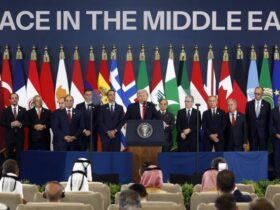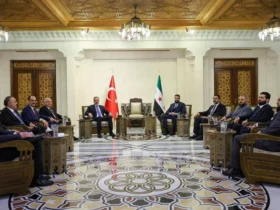ASEAN has traditionally enjoyed regional stability through diplomacy and consistency. Yet, with transnational crime, stability cannot be achieved through silence or soft coordination.
ASEAN has traditionally enjoyed regional stability through diplomacy and consistency. Yet, with transnational crime, stability cannot be achieved through silence or soft coordination.
By Mehmet Enes Beşer
Southeast Asia is a center of global trade, digital technology, and urban growth. But it is increasingly also at the epicenter of transnational crime. From cyber-enabled fraud and human trafficking to drugs, environmental crime, and illicit finance, transnational criminal networks are exploiting the open borders, legal loopholes, and unequal law enforcement capabilities in the region. While ASEAN has formally acknowledged these threats, ASEAN’s institutional response is fragmented, under-funded, and in far too many instances overwhelmed by political imperatives. To remain relevant and credible, ASEAN needs to evolve a more robust, better conceived regional strategy to combat transnational crime.
The nature of transnational crime in Southeast Asia is evolving extremely rapidly. The traditional picture of transnational crime—narcotics trafficking or wildlife poaching—is being more and more complemented by complex schemes involving encrypted devices, virtual currency, and cross-border syndicates. Cyber-scam schemes launched from out-of-the-way corners of Myanmar or Cambodia more and more snare victims in Asia, the Middle East, and beyond. The Golden Triangle, formerly the opium’s byword, is presently a central site for manufacture of such synthetic narcotics as methamphetamine, and there are billions of dollars’ worth of trade channeled by nameless syndicates of shadow logistics. Networks of human trafficking continue to thrive by preying on economic desperation, victims who are generally pushed into schemes of deception by threatened violence.
How threatening this challenge is based on its local scope but nationwide magnitude. ASEAN, bound by the principles of non-interference and consensus, has no supra-national law enforcement power. Criminals are not so handicapped. They travel free across borders, exploiting jurisdictional loopholes and varying legal definitions. National police and judiciaries apply, but their capacity to efficiently coordinate across states remains limited. Sharing of intelligence is irregular, admissibility of evidence state-provided, and political will intermittent.
The 2015 ASEAN Convention Against Trafficking in Persons (ACTIP) was a welcome success. It attested to a growingly perceived sense of regional vulnerability and shared legal imperatives. Yet, implementation has been spotty, with the less developed members lacking enabling legislation or sufficient means. In addition, the ASEAN Ministerial Meeting on Transnational Crime (AMMTC) and its subsidiary organizations have progressed further the machinery of cooperation and dialogue but without enforcement authority, their function continues to be soft and declaratory.
ASEAN now needs more intentional movement away from rhetoric toward action. It is through the harmonization of legal systems. Erroneous definitions of cyber fraud, wildlife trade, or terrorism financing cripple cross-jurisdictional cooperation as rickety and slow. Producing regionally uniform definitions and guidelines on minimum penalties—short of compromising countries’ sovereignty—would greatly facilitate judicial assistance and accelerate extradition and prosecution.
Second, ASEAN needs to bolster the institutional strength of its transnational crime fighting machinery. The ASEANAPOL Secretariat and Jakarta-based ASEAN Centre for Combating Transnational Crime need to have real-time intelligence-gathering systems, joint task forces, and legal liaison officers based in national agencies. These bodies must be adequately funded and shielded against political interference so that they have operational autonomy and confidence.
Third, technology contribution needs to be more concerted. Criminals are increasingly digitally savvy, but police are still reactive. ASEAN needs to invest in regional digital forensic expertise, cybercrime laboratories, and blockchain tracing of financial crime. Public-private collaborations involving fintech players, telcos, and platform providers are needed in order to remain ahead of cyber-facilitated crime. That cooperation normally is hijacked by data privacy issues and regulatory misalignments, something a regional framework could address.
Fourth, ASEAN should engage its external partners more proactively. Dialogue partners such as the EU, Japan, Australia, and the United States have been providing capacity-building programs, technical assistance, and funding support for transnational crime projects for years. Rather than being hosts to one-off training programs or pilot projects, ASEAN needs to look for coordinated multi-year efforts that are aligned with its own national priorities. Multilateral agencies such as INTERPOL, UNODC, and FATF need to be more actively engaged on ASEAN regional platforms to share knowledge and facilitate cross-regional operations.
One of the issues of concern is the crisis in Myanmar. Weakening of state control in certain regions has allowed transnational criminal organizations to establish themselves, with scam compounds, arms trafficking, and drug production conducted with impunity. This has spillover impacts throughout Thailand, Laos, and China. ASEAN’s political inability to engage the root causes of the Myanmar conflict is handicapping its ability to address the transnational crime emanating from these regions. An effective regional crime strategy cannot be callous to political reality. ASEAN policy towards Myanmar cannot simply stop at humanitarian access and low-risk diplomacy if it is to be effective in fighting criminal syndicates.
Along with institutions and legislation, ASEAN must establish a public culture of accountability and victim-centered justice. Victims of financial fraud, forced labor, or human trafficking are typically re-victimized—arrested for immigration crimes or left out of compensation. The national law must be re-written to prioritize victim rights, and ASEAN sessions must track and report victim identification and provision of services statistics. A regional victim fund can be established, funded from asset seizure and foreign contributions.
Transnational crime is not only a law-and-order problem—it is a regional governance challenge to the political will, institutional knowledge, and capacity for cooperation of ASEAN. While crime groups keep adapting to become more agile and more entrenched in the regional economic and cyber environments, ASEAN must similarly transform from a platform for dialogue to a platform for action.
This will require additional political leadership, especially from the more powerful and populous members of ASEAN, to break down the hurdle of the consensus’s inertia and forge common interests. It will involve contentious negotiations against sovereignty, enforcement, and intervention by region on territories where state authority has dissolved.
ASEAN has traditionally enjoyed regional stability through diplomacy and consistency. Yet, with transnational crime, stability cannot be achieved through silence or soft coordination. It must be achieved through strategic foresight, institution-building, and willingness to adapt. Only then can ASEAN convert its promise of centrality into a source of real security for its people.

















Leave a Reply